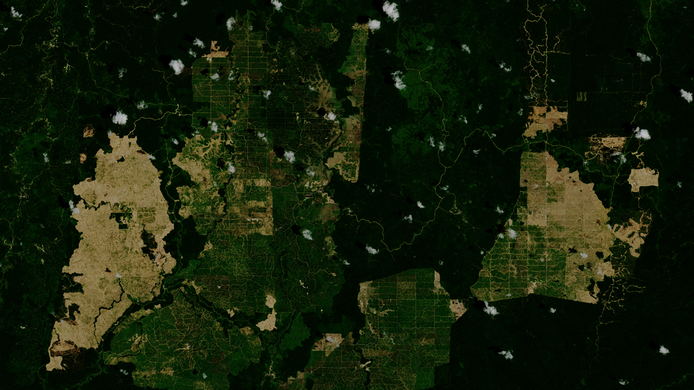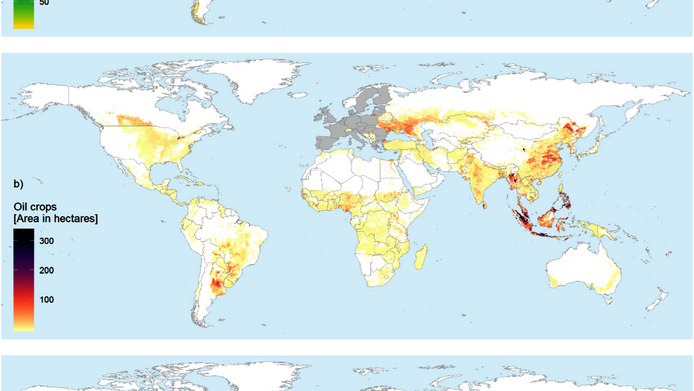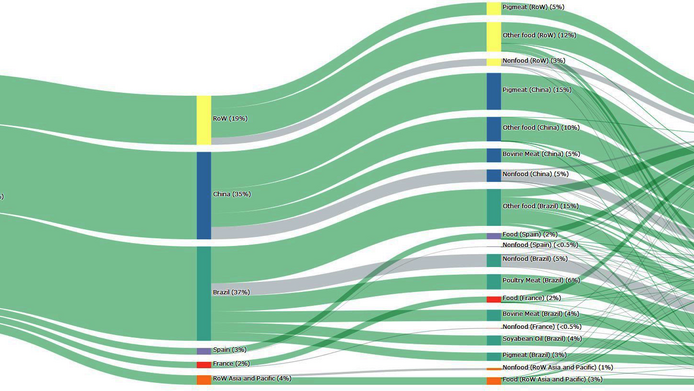Visualizing the environmental impact of consumerism

Maize is either eaten by humans, used as animal feed or fuels engines in the form of bioethanol. Wood can be used for heating, construction or chemical processing. Sugar cane is converted into fuel, sugar or spirits. Stefan Giljum from the Vienna University of Economics and Business Administration (WU Vienna) is particularly interested in the point where global material flows are split into the fuel or food routes. Giljum is the principal investigator of the MF-GLOBE project and, with the "Global Resource Use" research group which he heads, tracks and visualizes the origin and use of biomass and fossil fuels along value chains around the globe: “In a way we try to map the global economy by recording material flows from onset to end-use. The MF-GLOBE model should ultimately enable us to see how the consumption of individual products, for example in Europe, is related to the environmental impact of the cultivation or extraction of raw materials in the countries of origin,” explains Stefan Giljum.
From resources to consumption
When maize cobs are harvested, the geographical area, the method used and the crop volume have an impact on land use, the environment and society in the country of cultivation. In Austria, the country of consumption, none of the people who eat popcorn, feed pigs or fill their tanks with bioethanol feel any of these effects. The same applies to products made in China and the discussion about national contributions to the climate crisis. After all, the carbon dioxide emissions for goods (that are demanded worldwide) are allocated to the country of production. This is why being able to trace material flows is not only interesting from a research perspective. An increasing number of consumers are attentive to environmental considerations when buying goods, and individual companies, entire industries, as well as policy-makers—both national and international—also need reliable data and models for sustainable decisions on minimizing greenhouse gases and environmental pollution.
The research project MF-GLOBE tracks material flows from the place of origin to transport, processing and consumption. The project records the resource consumption of 190 countries with regard to specific product groups such as textiles, food or energy sources, and thus identifies hotspots of intensive environmental impact.

As the future strategy of the European Union, the bioeconomy is being widely discussed. This is defined as the switch from fossil to renewable sources in production processes and energy generation. It is essential, however, to assess the global consequences of such a change in Europe, for example in terms of land and water consumption. This is the only way to assess whether this can be achieved in a sustainable way on the one planet and its atmosphere that we have at our disposal.
Detailed and harmonized data
The research project MF-GLOBE tracks material flows from the place of origin to transport, processing and consumption. The project records the resource consumption of 190 countries with regard to specific product groups such as textiles, food or energy sources, and thus identifies hotspots of intensive environmental impact. In order to synthesize the material flows of the global economy in the model, the researchers at WU Vienna use the latest data, including what is published by various UN authorities. In addition, the team is developing suitable processes to harmonize data and bring it into a consistent framework. On the path from origin in the field, forest or extraction site to final consumption, the units of accounting undergo a transformation from energy content and tonnages in the first processing stages to transfers between economic sectors and household expenditure in the consumer countries, which are then expressed in euros.
Knowledge for sustainable strategies
Currently, there are still gaps in our understanding of the international production chains, which are often very complex. In many cases we are unaware of the relationship between our consumption habits and the environmental consequences on other continents, for instance in terms of carbon dioxide emissions, water consumption or the amount of land required for cultivation. We do know, however, that about 85% of the land used to produce food for the European Union is located within the EU. When it comes to the supply of fuel, plastics and so on from biogenic raw materials, about two thirds of the areas of cultivation are outside the EU. Currently, the origin of biomass or fossil energy sources can only be traced at the level of aggregated economic sectors.
Research groups around the world are working on creating more detailed models to facilitate a better understanding of the environmental impact of individual products. In the MF-GLOBE project, WU Wien is cooperating with other experts, including specialists from the Wuppertal Institute in Germany: “For biomass and fuels, we are building a model of the entire supply and value chain using the most precise data sources available. Ultimately, this offers assistance in decision-making to help reduce waste, land consumption or climate-damaging emissions,” notes Stefan Giljum in elaborating on further effects of the project, which is funded by the Austrian Science Fund FWF and will run until 2022.
Personal details
Stefan Giljum is head of the research group "Global Resource Use" at the Institute for Ecological Economics at the Vienna University of Economics and Business (WU). His areas of expertise include the analysis of resource use in production and consumption as well as the investigation of the environmental effects of globalization and international trade. In 2016 he received a highly endowed ERC grant from the European Research Council.
Publications
Quantifying the global cropland footprint of the European Union’s non-food bioeconomy, in: Environmental Research Letters 2019
The raw material basis of global value chains: allocating environmental responsibility based on value generation, in: Economic Systems Research 2018
Identifying priority areas for European resource policies: a MRIO-based material footprint assessment, in: Journal of Economic Structures 2016






